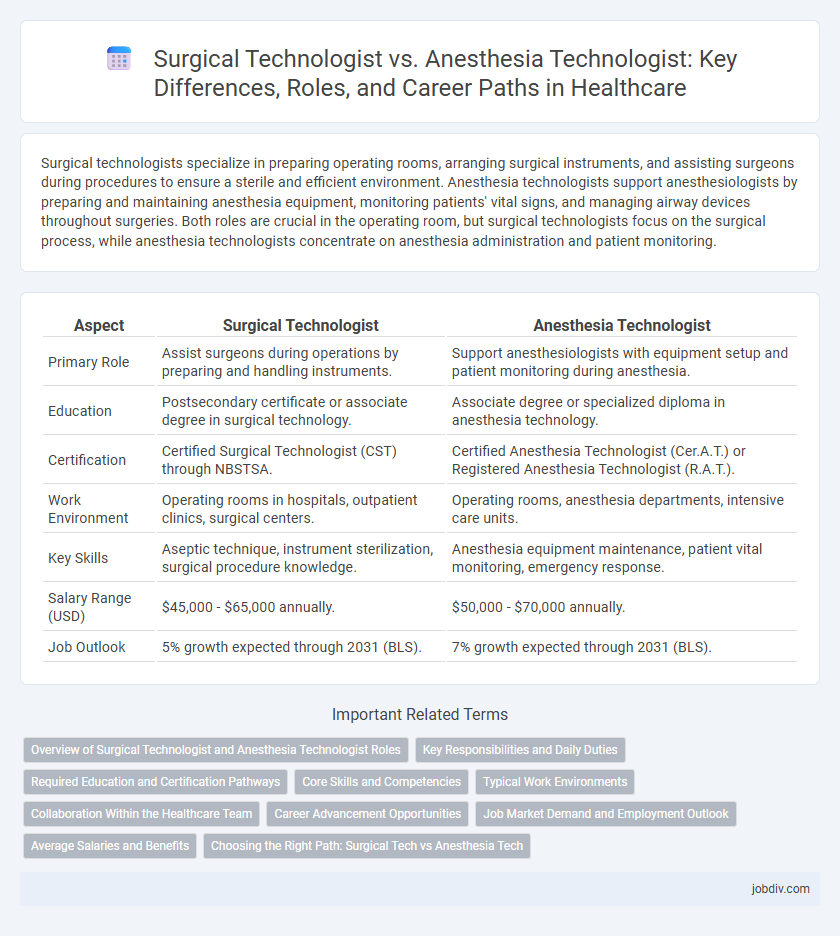Surgical technologists specialize in preparing operating rooms, arranging surgical instruments, and assisting surgeons during procedures to ensure a sterile and efficient environment. Anesthesia technologists support anesthesiologists by preparing and maintaining anesthesia equipment, monitoring patients' vital signs, and managing airway devices throughout surgeries. Both roles are crucial in the operating room, but surgical technologists focus on the surgical process, while anesthesia technologists concentrate on anesthesia administration and patient monitoring.
Table of Comparison
| Aspect | Surgical Technologist | Anesthesia Technologist |
|---|---|---|
| Primary Role | Assist surgeons during operations by preparing and handling instruments. | Support anesthesiologists with equipment setup and patient monitoring during anesthesia. |
| Education | Postsecondary certificate or associate degree in surgical technology. | Associate degree or specialized diploma in anesthesia technology. |
| Certification | Certified Surgical Technologist (CST) through NBSTSA. | Certified Anesthesia Technologist (Cer.A.T.) or Registered Anesthesia Technologist (R.A.T.). |
| Work Environment | Operating rooms in hospitals, outpatient clinics, surgical centers. | Operating rooms, anesthesia departments, intensive care units. |
| Key Skills | Aseptic technique, instrument sterilization, surgical procedure knowledge. | Anesthesia equipment maintenance, patient vital monitoring, emergency response. |
| Salary Range (USD) | $45,000 - $65,000 annually. | $50,000 - $70,000 annually. |
| Job Outlook | 5% growth expected through 2031 (BLS). | 7% growth expected through 2031 (BLS). |
Overview of Surgical Technologist and Anesthesia Technologist Roles
Surgical Technologists assist surgeons during operations by preparing the sterile field, handling instruments, and ensuring a safe surgical environment. Anesthesia Technologists support anesthesiologists by preparing and maintaining anesthesia equipment, monitoring patient status, and managing airway devices. Both roles require specialized training, but Surgical Technologists focus primarily on intraoperative support while Anesthesia Technologists concentrate on anesthesia care and equipment management.
Key Responsibilities and Daily Duties
Surgical technologists prepare operating rooms, arrange surgical instruments, and assist surgeons during procedures by passing tools and maintaining sterile environments, ensuring patient safety and efficiency. Anesthesia technologists manage anesthesia equipment, prepare medications under anesthesiologist supervision, and monitor the functionality of life-support systems throughout surgical operations. Both roles demand precise attention to detail and strong teamwork to support successful surgical outcomes.
Required Education and Certification Pathways
Surgical technologists typically complete a postsecondary certificate or associate degree from an accredited surgical technology program, followed by certification such as the Certified Surgical Technologist (CST) credential obtained through the National Board of Surgical Technology and Surgical Assisting (NBSTSA). Anesthesia technologists generally pursue an associate degree or specialized training in anesthesia technology, with certification options including the Certified Anesthesia Technologist (Cer.A.T.) credential offered by the American Society of Anesthesia Technologists and Technicians (ASATT). Both professions require rigorous clinical training, but anesthesia technologists often receive more focused education in anesthetic equipment and patient monitoring.
Core Skills and Competencies
Surgical technologists excel in sterile field maintenance, instrument handling, and patient preparation for surgery, ensuring efficient operating room workflow. Anesthesia technologists specialize in equipment setup, anesthesia monitoring, and emergency troubleshooting, supporting anesthesiologists during procedures. Both roles require strong knowledge of medical terminology, attention to detail, and teamwork to optimize patient safety and surgical outcomes.
Typical Work Environments
Surgical technologists commonly work in operating rooms within hospitals and outpatient surgical centers, assisting surgeons during procedures by preparing instruments and maintaining sterile environments. Anesthesia technologists typically operate in anesthesia departments of hospitals, critical care units, and surgical suites, supporting anesthesiologists with equipment setup, monitoring, and maintenance. Both roles demand proficiency in medical technology and teamwork but differ in their specialized focus and clinical settings.
Collaboration Within the Healthcare Team
Surgical technologists and anesthesia technologists collaborate closely to ensure patient safety and procedural efficiency during surgeries, each specializing in distinct but complementary responsibilities. Surgical technologists prepare the operating room and assist surgeons by handling instruments and maintaining a sterile environment, while anesthesia technologists support anesthesiologists by managing anesthesia equipment and monitoring patients' vital signs. Effective communication between these technologists enhances teamwork, reduces risks, and contributes to successful surgical outcomes within multidisciplinary healthcare teams.
Career Advancement Opportunities
Surgical Technologists often advance their careers by specializing in areas such as perioperative nursing or surgical assistant roles, benefiting from certifications like the Certified Surgical Technologist (CST). Anesthesia Technologists pursue career growth through gaining expertise in anesthesia equipment management, assisting anesthesiologists, and obtaining credentials like the Certified Anesthesia Technician (Cer.A.T.). Both professions provide pathways for leadership roles in hospital settings, education, and specialized technical positions within the healthcare industry.
Job Market Demand and Employment Outlook
The job market demand for Surgical Technologists is robust, driven by the rising number of surgeries and advancements in medical technology, with the U.S. Bureau of Labor Statistics projecting a 9% growth rate from 2022 to 2032. Employment outlook for Anesthesia Technologists is more specialized but growing steadily due to increased reliance on anesthesia equipment and the need for skilled support in surgical teams. Both roles require technical expertise, but Surgical Technologists generally have broader job opportunities in hospitals, outpatient centers, and surgical clinics.
Average Salaries and Benefits
Surgical technologists earn an average salary of $48,000 annually, with benefits including health insurance, paid time off, and retirement plans. Anesthesia technologists typically make around $54,000 per year, often receiving similar benefits along with specialized certifications that can enhance job security and career advancement. Salary variations depend on experience, location, and healthcare facility type for both professions.
Choosing the Right Path: Surgical Tech vs Anesthesia Tech
Surgical Technologists specialize in preparing operating rooms and assisting surgeons during procedures, focusing on sterile techniques and instrument management. Anesthesia Technologists support anesthesiologists by maintaining and monitoring anesthesia equipment, ensuring patient safety during sedation. Choosing the right path depends on whether you prefer a hands-on surgical environment or a focus on anesthesia technology and patient sedation monitoring.
Surgical Technologist vs Anesthesia Technologist Infographic

 jobdiv.com
jobdiv.com